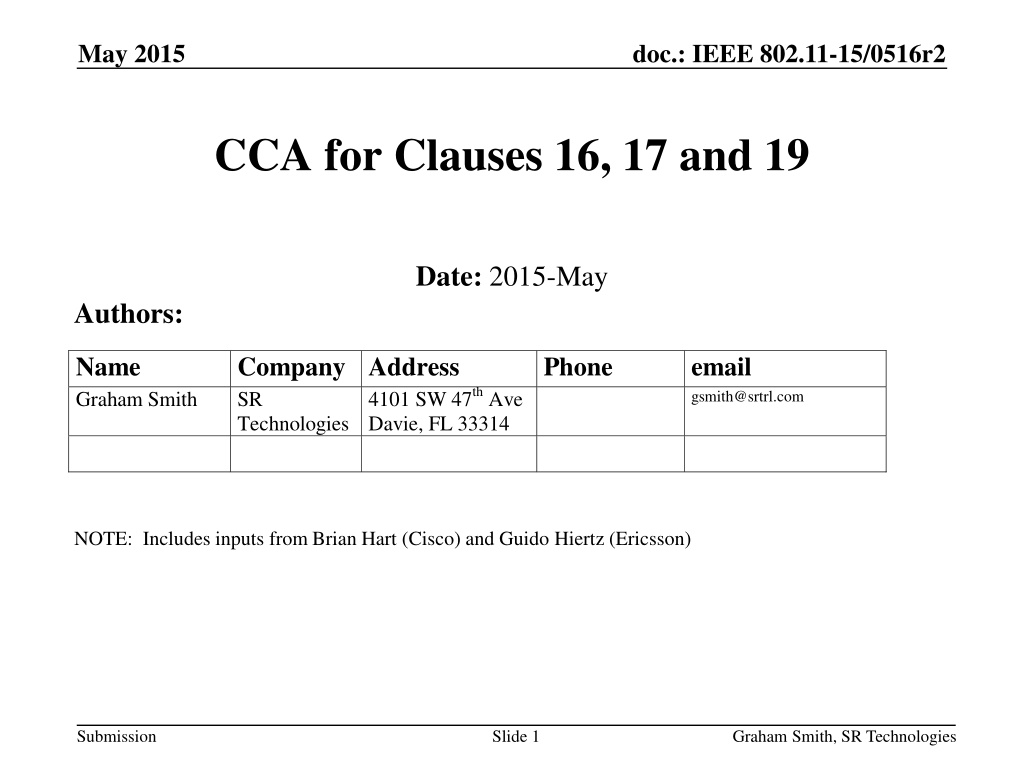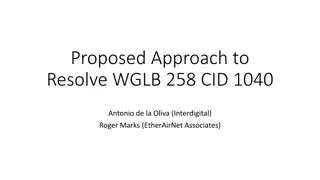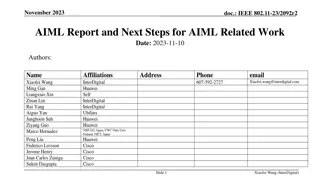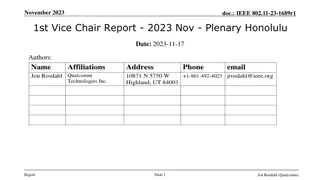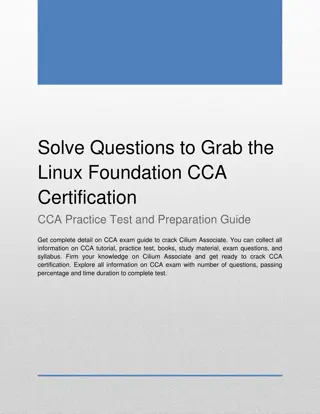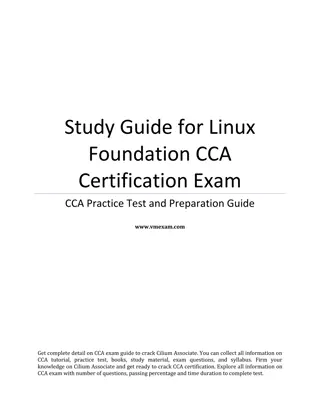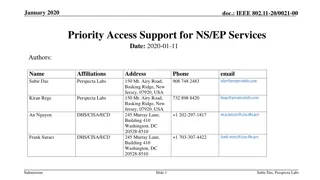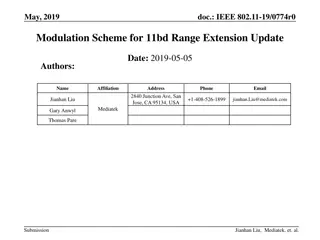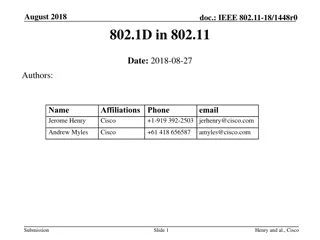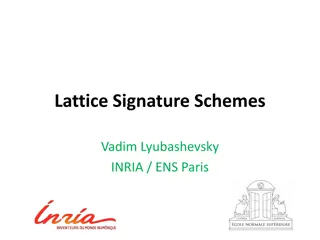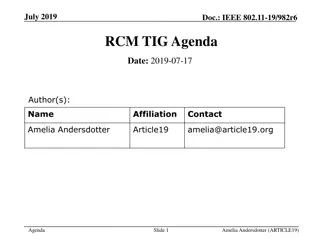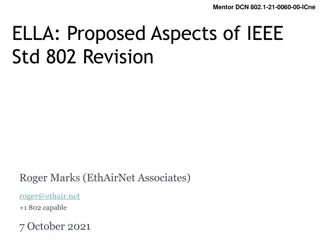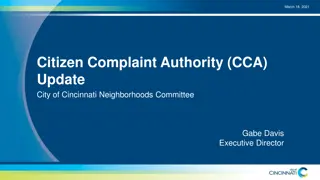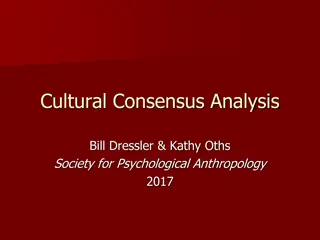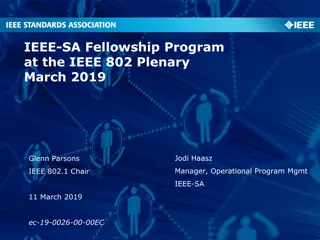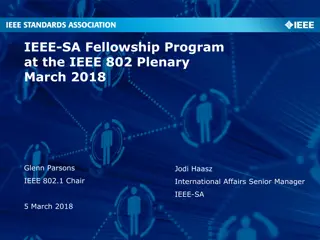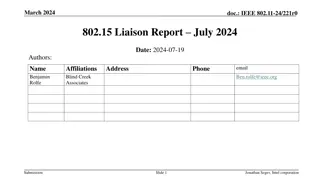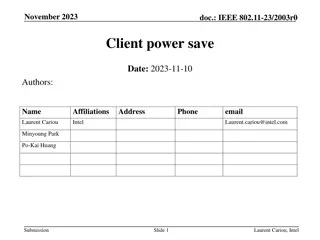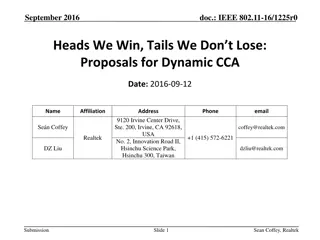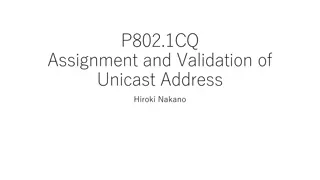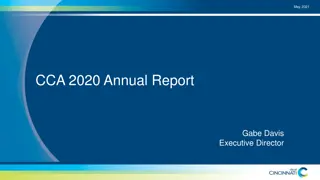Proposed Changes to CCA Schemes in IEEE 802.11 Standards
The submission discusses proposals to enhance the Clear Channel Assessment (CCA) schemes for IEEE 802.11 standards, particularly focusing on Clauses 16, 17, and 19. It addresses the current limitations in CCA schemes for different devices and suggests modifications to ensure compliance and efficient spectrum utilization. The proposal aims to improve interoperability and performance of 11b, 11g, and 11n devices by adjusting the energy detection thresholds and protection mechanisms. Overall, the suggested changes aim to optimize the use of different CCA schemes in various IEEE 802.11 devices.
Download Presentation

Please find below an Image/Link to download the presentation.
The content on the website is provided AS IS for your information and personal use only. It may not be sold, licensed, or shared on other websites without obtaining consent from the author.If you encounter any issues during the download, it is possible that the publisher has removed the file from their server.
You are allowed to download the files provided on this website for personal or commercial use, subject to the condition that they are used lawfully. All files are the property of their respective owners.
The content on the website is provided AS IS for your information and personal use only. It may not be sold, licensed, or shared on other websites without obtaining consent from the author.
E N D
Presentation Transcript
May 2015 doc.: IEEE 802.11-15/0516r2 CCA for Clauses 16, 17 and 19 Date: 2015-May Authors: Name Graham Smith Company Address SR Technologies Phone email gsmith@srtrl.com 4101 SW 47th Ave Davie, FL 33314 NOTE: Includes inputs from Brian Hart (Cisco) and Guido Hiertz (Ericsson) Submission Slide 1 Graham Smith, SR Technologies
May 2015 doc.: IEEE 802.11-15/0516r2 Background The standard presently allows an 11b Clause 16 STA to just use one of three CCA schemes: ED-CCA, CS and CS with ED threshold. Similarly Clause 17 devices also have a choice. However, because many (if not all) 11b devices use just CS, 11g OFDM transmissions must use protection mechanism that is usually a RST/CTS or CTS-to-self. As it stands an 11b device using only CS-CCA is not compliant with EN 300 328 V1.8.1 which specifies ED-CCA at -58dBm minimum. Clause 19 and 20 devices must use both CS-CCA and ED-CCA. NOTE: This proposal would not affect present 11b devices but would affect new 11b implementations. Submission Slide 2 Graham Smith, SR Technologies
May 2015 doc.: IEEE 802.11-15/0516r2 Summary of existing CCA Specs Description Min RX Clause CCA -CS Energy Detect CCA 11b devices tends to use these 16 DSSS 1, 2Mbps 16.4.6.3 -80dBm @ 2Mbps) One of following: 1 above ED 2 any DSSS 3 DSSS above ED One of following: 1 above ED 4 any HR (with timer) 5 HR above ED -80dBm >100mW -76dBm >50<100mW -73dm <50mW 17 CCK 5.5, 11Mbps 17.3.8.2 -76dBm @ 11Mbps -76dBm >100mW -73dBm >50<100mW -70dm <50mW -82dBm 18 11a OFDM 18.3.10.6 -82dBm 20MHz -85dBm 10MHz -88dBm 5MHz -82dBm 20MHz -85dBm 10MHz -88dBm 5MHz Mandatory -62dBm 20MHz -65dBm 10MHz -68dBm 5MHz -62dBm 19 11g ERP 19.4.6 -82dBm 20MHz Valid signal -76dBm No Spec 20 11n 20.3.20.5.2 -82dBm 20MHz -79dBm 40MHz HT signal -82dBm 20MHz -79dBm 40MHz -62dBm 20MHz -59dBm 40MHz If not support HT-GF -72dBm for HT-GF (20MHz) -69dBm for HT-GF (40MHz) 22 11ac 22.3.18.5 Primary Channel -82dBm 20MHz -79dBm 40MHz -76dBm 80MHz -73dBm 160MHz Secondary channel Any signal -62dBm 20MHz -59dBm 40MHz -72dBm in any 20MHz of 40MHz Submission Slide 3 Graham Smith, SR Technologies
May 2015 doc.: IEEE 802.11-15/0516r2 ETSI EN 300 328 V1.8.2 The energy detection threshold for the CCA shall be proportional to the transmit power of the transmitter: for a 20 dBm e.i.r.p. transmitter the CCA threshold level (TL) shall be equal or lower than -70 dBm/MHz at the input to the receiver (assuming a 0 dBi receive antenna). For power levels below 20 dBm e.i.r.p. the CCA threshold level may be relaxed to TL = -70 dBm/MHz + 20 - Pout e.i.r.p. (Pout in dBm). In a 20MHz channel, this requirement equates to about -62dBm. This creates the Upper Limit for energy detect CCA. Submission Slide 4 Graham Smith, SR Technologies
May 2015 doc.: IEEE 802.11-15/0516r2 Discussion on 11b CCA OFDM, 11g and 11n recognize the 11b preamble and hence in practice we have the -82dBm CCA threshold between 11g/n and 11b DSSS and CCK do not recognize an OFDM preamble even though they share the band AND are 802.11. Hence OFDM 11g/11n need to use protection which reduces throughput. This is because 11b can choose the valid signal only option (which they do) BUT OFDM 11g and 11n DO recognize DSSS and CCK at the -82dBm threshold because they understand 11b. For Fair Sharing , 11b could recognize OFDM at about the -82dBm threshold, and this would be energy detect CCA Note: The ED/CCA is presently set to -80dBm BUT not mandated IF Clause 16 , 17 ED/CCA was mandated, then 11g, 11n and 11b could share equally and OFDM 11g/n would not need to send CTS or protective mechanism. Submission Slide 5 Graham Smith, SR Technologies
May 2015 doc.: IEEE 802.11-15/0516r2 Basic Options A. Make energy detect CCA mandatory for Clause 16 and 17. Minor change, just make CCA-Mode 1 mandatory. Still allow valid signal threshold Provides for 11b, 11g and 11n all sharing fairly and could eliminate the need for 11g/n OFDM to use protection with the associated efficiency improvement Leave all the clause 16/17 CCA as is (select one of 3) BUT add mandatory -62dBm energy detect CCA requirement. Minimum change but does bring 11b into line with ETSI. If device chooses the ED/CCA then same as A, but not mandated. As OFDM is seen as energy , 11g/n may need to use protection for themselves. Bring 11b CCA into line with others, mandate -82dBm valid signal, with -62dBm energy detect CCA As OFDM is seen as energy , 11g/n may need to use protection for themselves. B. C. Submission Slide 6 Graham Smith, SR Technologies
May 2015 doc.: IEEE 802.11-15/0516r2 Option A Clause 16.4.6.5 Existing Text: The DSSS PHY shall provide the capability to perform CCA according to at least one of the following three methods CCA Mode 1: Energy above threshold. CCA shall report a busy medium upon detection of any energy above the ED threshold. (Note: This is -80dBm) CCA Mode 2: CS only. CCA shall report a busy medium only upon detection of a DSSS signal. This signal may be above or below the ED threshold. CCA Mode 3: CS with energy above threshold. CCA shall report a busy medium upon detection of a DSSS signal with energy above the ED threshold. Revised Text: The DSSS PHY shall perform CCA according to CCA Mode 1 and may also provide the capability to perform CCA according to CCA Mode 2 or CCA mode 3. CCA Mode 1: Energy above threshold. CCA shall report a busy medium upon detection of any energy above the ED threshold CCA Mode 2: CS only. CCA shall report a busy medium only upon detection of a DSSS signal. This signal may be above or below the ED threshold. CCA Mode 3: CS with energy above threshold. CCA shall report a busy medium upon detection of a DSSS signal with energy above the ED threshold. Similar change for Clause 17.3.8.5 Submission Slide 7 Graham Smith, SR Technologies
May 2015 doc.: IEEE 802.11-15/0516r2 Option B Clause 16.4.6.5 Existing Text: The DSSS PHY shall provide the capability to perform CCA according to at least one of the following three methods CCA Mode 1: Energy above threshold. CCA shall report a busy medium upon detection of any energy above the ED threshold. (NOTE: This is -80dBm) CCA Mode 2: CS only. CCA shall report a busy medium only upon detection of a DSSS signal. This signal may be above or below the ED threshold. CCA Mode 3: CS with energy above threshold. CCA shall report a busy medium upon detection of a DSSS signal with energy above the ED threshold. Revised Text: The DSSS PHY shall provide the capability to perform CCA according to both: A At least one of the following options: CCA Mode 1: Energy above threshold. CCA shall report a busy medium upon detection of any energy above the ED threshold. CCA Mode 2: CS only. CCA shall report a busy medium only upon detection of a DSSS signal. This signal may be above or below the ED threshold. CCA Mode 3: CS with energy above threshold. CCA shall report a busy medium upon detection of a DSSS signal with energy above the ED threshold. And B CCA-ED coarse: Energy above threshold. CCA shall report a busy medium upon detection of any energy above -62dBm. Similar change for Clause 17.3.8.5 Submission Slide 8 Graham Smith, SR Technologies
May 2015 doc.: IEEE 802.11-15/0516r2 Option C Clause 16.4.6.5 Existing Text: The DSSS PHY shall provide the capability to perform CCA according to at least one of the following three methods CCA Mode 1: Energy above threshold. CCA shall report a busy medium upon detection of any energy above the ED threshold. CCA Mode 2: CS only. CCA shall report a busy medium only upon detection of a DSSS signal. This signal may be above or below the ED threshold. CCA Mode 3: CS with energy above threshold. CCA shall report a busy medium upon detection of a DSSS signal with energy above the ED threshold. Revised Text: The DSSS PHY shall provide the capability to perform CCA according to both: CCA Mode 1: Energy above threshold. CCA shall report a busy medium upon detection of any energy above the ED threshold. CCA Mode 2: CS only. CCA shall report a busy medium only upon detection of a DSSS signal above a receive level of - 82dBm. Then change the ED threshold The ED threshold shall be <= -62 dBm. Similar change for Clause 17.3.8.5 Submission Slide 9 Graham Smith, SR Technologies
May 2015 doc.: IEEE 802.11-15/0516r2 Aside The following note would be inserted {Note to 802.11REVmc reader, to be removed before publication. The following change has no force until REVmc is ratified (for anticipated ratification date, see http://www.ieee802.org/11/Reports/802.11_Timelines.htm). Pre-existing HR/DSSS STAs compliant to 802.11-2012 remain compliant to 802.11-2012.} Simply clarifying that the change would only affect new 11b devices. Submission Slide 10 Graham Smith, SR Technologies
May 2015 doc.: IEEE 802.11-15/0516r2 Quick Recap (Intro to Straw Poll) Option A Mandate energy detect CCA for 11b Already a choice Meets ETSI requirement Puts 11b and 11g/n on equal sharing, fairness 11g/n recognize 11b at -82dBm 11b would recognize 11g/n at -80dBm Could eliminate protection requirement and improve efficiency for 11g/n (Clause 9.26.2 Protection mechanism for non-ERP receivers) Only point is that NAV not set by OFDM. Option B Mandate -62dBm energy detect CCA for 11b Meets ETSI requirement Still requires protection for 11g/n Option C Mandate -62dBm energy detect CCA, -82dBm for valid signal 11b Meets ETSI requirement Common requirement, Still requires protection for 11g/n Submission Slide 11 Graham Smith, SR Technologies
May 2015 doc.: IEEE 802.11-15/0516r2 Straw Poll - A Would you support a change to the CCA for DSSS and CCK along the lines as described for Option A, B or C Yes No Submission Slide 12 Graham Smith, SR Technologies
May 2015 doc.: IEEE 802.11-15/0516r2 Straw Poll - B Which Option would you prefer for 11b devices? Option A Mandate energy detect CCA (-80dBm, 100mw TX) Option B - Add mandatory -62dBm energy detect CCA Option C Mandate -82dB valid signal and -62dBm energy detect CCA. A B C No preference Submission Slide 13 Graham Smith, SR Technologies
